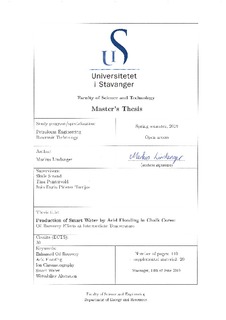| dc.description.abstract | Considering that most carbonates are of low water wetness, it is of great interest to inject a brine that can alter the wettability to enhance oil production. Smart Water injection has therefore become the most meaningful EOR flooding technique in chalk reservoirs in recent years. The EOR technology is based on tuning the ionic composition of the injection brine to increase the water-wetness of the reservoir, which induces stronger capillary forces and increased microscopic sweep efficiency. Injection of seawater (SW) has already proven to be a great success at the chalk reservoir Ekofisk, and is considered as an excellent wettability modifier. However, research has shown that SW enriched in SO 2–4 and Ca2+ and depleted in monovalent ions is even more efficient at wettability alteration (Fathi, 2012).
The purpose of this thesis is therefore to test if an improved Smart Water can be produced by injecting sulphuric acid into chalk outcrop cores. The acid will then provide SO 2–4-ions, and dissolution of chalk will add Ca2+-ions to the solution. The produced Smart Water then contains the necessary potential determining ions and at the same time is of low salinity.
In the first part of the experiment, sulphuric acid concentrations of 9.7, 13.3 and 16.7 mM were flooded at 70 ◦C, while 4.9 and 8.5 mM were flooded at 130 ◦C. Ion chromatography (IC) analysis of the effluent from the acid flooding was then performed to evaluate the composition of the produced Smart Water. In the second part, oil recovery by spontaneous and forced imbibition was conducted at 90 ◦C with Smart Water and SW. Gypsum was used as Smart Water to represent the brine produced by acid flooding, to simplify the experimental test. FW was imbibed at 70 ◦C to have a reference where no wettability alteration takes place. The experiments were performed to study the performance of the Smart Water relative to SW. Tree cores saturated with Swi= 10 % VB0S and Soi= 90 % oil with AN=0.5 mgKOH/g with permeabilities 4.65-5.14 mD and porosities 48-49 % were used for the experiment. In the third part of the experiment, the effect temperature has on wettability alteration was investigated, by comparing the performance of Smart Water and SW at 90 ◦C, with a parallel study performed at 70 ◦C with the exact same fluids.
The IC-analysis of the effluent from the acid flooding, show that the Smart Water acquires a composition of SO 2–4 and Ca2+ in a 1:1 proportion. The oil recovery by spontaneous imbibition for FW, SW and Smart Water were, 10 %, 24% and 27 % OOIP, respectively. The corresponding modified Amott water index for the fluids in the same order, was I*W −SI = 0.13, I*W −SI = 0.31 and I*W −SI = 0.36. The same trend was seen with the Amott water index, with IW= 0.18, IW= 0.44 and IW=0.49, for FW, SW and Smart Water. The temperature show a clear effect on the wettability alteration with both Smart Water and SW producing 14-16 % more at 90 ◦C compared at 70 ◦C by spontaneous imbibition.
Results from the experiments therefore confirm that a Smart Water of low salinity can be produced by injecting sulphuric acid into Stevns Klint chalk outcrop cores. When the acid solution is transported across the core, it establishes an equilibrium with the chalk surface and obtains an equal proportion of Ca2+-ions and SO 2–4-ions. Based on the imbibition rate and ultimate recovery from the spontaneous imbibition, along with the modified Amott water index and normal Amott water index, a conclusion can be made that the Smart Water is slightly more efficient than SW at increasing the water wetness at 90 ◦C. | nb_NO |

